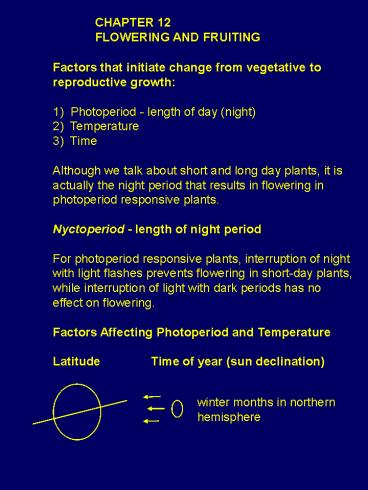Dr' Bennett copy PowerPoint PPT Presentation
1 / 8
Title: Dr' Bennett copy
1
CHAPTER 12 FLOWERING AND FRUITING
Factors that initiate change from vegetative
to reproductive growth 1) Photoperiod - length
of day (night) 2) Temperature 3) Time Although
we talk about short and long day plants, it is
actually the night period that results in
flowering in photoperiod responsive
plants. Nyctoperiod - length of night
period For photoperiod responsive plants,
interruption of night with light flashes prevents
flowering in short-day plants, while interruption
of light with dark periods has no effect on
flowering. Factors Affecting Photoperiod and
Temperature Latitude Time of year (sun
declination)
winter months in northern hemisphere
2
- Daylength Responses
- Short-day plants Flowering is promoted by
- daylengths shorter than a critical maximum
(soybean, mammoth tobacco, maize, sorghum) - Long-day plants - Flowering is promoted by
- daylengths longer than a critical minimum.
- Day-neutral plants - Flowering is insensitive to
- day-lengths associated more with age (many
tropical plants) - Short- and long-day plants - Flowering is
promoted by a sequence of long days followed by
short days. - In most crops, a basic vegetative stage is
required - before flowering can occur, regardless of the
length of
3
Vernilization
Some plants will not flower even if grown in an
optimal photoperiod, unless they are exposed to
a cold period during vegetative growth. This
cold period known as VERNALIZATION (wheat,
sugarbeet, rye).
4
Photoperiodism - Effect of day length (night
length) on plants. Thermoperiodism -
Vernalization - Requirement for cold temperature
to stimulate flowering.
PHYTOCHROME
R Red light (600-680 nm) FR Far Red Light
(720-750 nm)
Inhibits flowering in short-day plants promotes
flowering in long-day plants
Long dark period allows more Pfr to revert back
to Pr.
Long days and short nights produces increased
Pfr (inhibits flowering in short-day plants)
5
P Phytochrome (pigment) exists in a red form
(Pr) or far-red (Pfr) form.
Temperature modifies the reversion of Pfr to Pr
Warm temperature increases rate of Pfr
to Pr Receptors of photoperiod
Leaves Receptors of vernalization
Meristems Florigen Vernalization Neither
compound has been isolated or characterized so
their existence remains only conjecture
hypothesized as plant-produced hormones that
promote flowering
6
(No Transcript)
7
Reproductive Growth
Floral initiation - occurs after floral
induction, and is the morphological transition of
meristems from a vegetative to a floral
state. Fruit set - Failure of most flowers to
set fruit is the rule rather than the
exception. - 50 to 75 failure is not
uncommon Reasons Lack of pollination (leaf
desiccation) and fertilization (weak pollen,
incompatibility) abortion of flowers and fruits
8
REPRODUCTIVE GROWTH 1) Flower induction 2)
Flower initiation 3) Pollination 4)
Fertilization 5) Seed set 6) Seed growth 7)
Seed maturation

